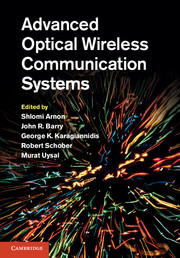15 - Optical wireless in sensor networks
from Part IV - Applications
Published online by Cambridge University Press: 05 June 2012
Summary
Introduction
Wireless sensor networks have been an active area of research for the past few decades [1, 2]. The availability of low-power radio communications, microprocessors, and sensors at low cost has led to highly capable sensor “motes” that can be connected in wireless networks (see for instance [3]). Environmental monitoring [[2], monitoring of structures [4, 5], industrial process control [6], and mechanical systems [7] have all used wireless sensor networks, and such deployments are likely to become much more widespread. The next generation of appliances and objects will be part of the Internet of Things [8], and these will be connected wirelessly to each other and to an information infrastructure. Reduction in carbon emissions will require a smart electrical grid [9] that allows for local generation of power and control of its use within the home at the appliance level. This will in turn require large numbers of sensors and actuators which will both monitor and control generators and appliances.
In the field of healthcare the ageing population will lead to greater demands on resources, and home monitoring of patients has the potential to prolong life and quality of life whilst reducing demands on resources. Body area networks of sensors are being pursued as means to collect data to allow this [10].
A major challenge for sensor networks is that of prolonging sensor node lifetime, which is usually limited by battery capacity. An ideal sensor node would scavenge all the energy required from its environment, and therefore have an “infinite” operating life, barring failure.
Information
- Type
- Chapter
- Information
- Advanced Optical Wireless Communication Systems , pp. 369 - 387Publisher: Cambridge University PressPrint publication year: 2012
